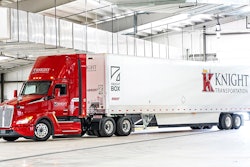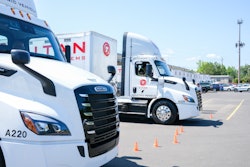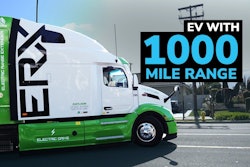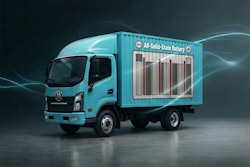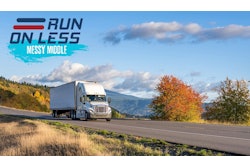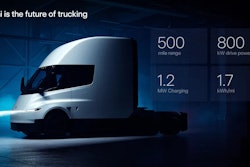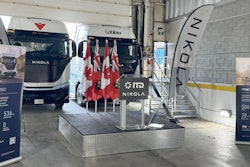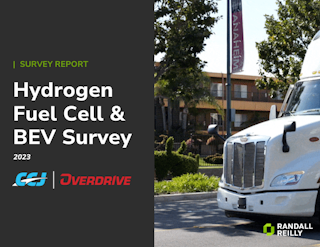In a world juiced by the prospect that electric vehicle power will be the commonsense solution to ever volatile petroleum prices and the rising ravages of climate change, alternative fuels like biodiesel, natural gas, and propane can seem like yesterday’s news.
But they’re far from that. And they won’t be, not until the challenges of building out a nationwide BEV charging infrastructure and lowering the acquisition costs of electric trucks are met. In this in-between time of electric-drive development – what the North American Council for Fuel Efficiency (NACFE) has dubbed “the messy middle” – today’s cleaner diesel power will reign along with the proven half dozen alternative fuels that run yet cleaner and are well-matched to various truck applications.
Combined, these fuels cover a range of applications, from dedicated, LTL, and truckload hauling to drayage and light/medium-duty delivery as well as such vocational uses as refuse, dump, and concrete mixer trucks.
The magnificent six alternatives are Biodiesel, Renewable Diesel, Compressed Natural gas (CNG), Liquefied natural gas (LNG), Renewable Natural Gas (both CNG and LNG), and Liquid Propane (LP), aka either Liquified Petroleum Gas (LPG) or Propane Autogas.
The grandaddy
By any name, propane is the grandaddy of alternative fuels. A byproduct of both natural gas processing and crude oil refining, it first appeared as an engine fuel in 1913. Today, LP is now the third most widely used automotive fuel behind gasoline and diesel in the U.S., according to ROUSH CleanTech, provider of propane technology for medium-duty Ford commercial vehicles.
Engine maker Cummins Inc. views propane as one of the most readily available alternatives. Its uses in trucking are for domiciled fleets. “Centralized, regional, and return-to-home base fleets are well suited for propane autogas vehicles,” Cummins advises, noting that LP benefits suburban and rural fleets as it uses easy, affordable, and scalable infrastructure. “Most propane fleets own their fueling infrastructure due to low installation costs, but drivers can also access over 2,600 public refueling sites across the U.S.” Medium-duty propane trucks are available as factory-built OEM models and EPA/CARB-certified aftermarket conversions.
Dynamic duo
Compressed Natural Gas and Liquefied Natural Gas share most of their positive attributes as alternative fuels. The big difference is in application: CNG fits centrally fueled fleets and LNG is specifically for long-haul fleets.
CNG is appropriate for high-mileage, centrally fueled fleets because they can provide similar fuel range support for applications that stay within a region, advises the Department of Energy’s Alternative Fuels Data Center (AFDC). “For vehicles that travel long distances, LNG offers a greater energy density than CNG, meaning the fuel range is more comparable to conventional fuel,” states AFDC. “The advantages of natural gas as a transportation fuel include its domestic availability, widespread distribution infrastructure, and reduced greenhouse gas emissions over conventional gasoline and diesel fuels.”
CNG vehicles store natural gas in a gaseous state under pressure, but more fuel can be stored onboard an LNG truck because the fuel is stored as a liquid, making its energy density greater than that of CNG. “This makes LNG well suited for Class 7 and 8 trucks requiring a greater range,” points out AFDC. “Often, the fuel choice is determined by factors such as vehicle application needs (e.g., power requirements) and the required driving range.
AFDC also points out that the horsepower, acceleration, and cruise speed of natural gas vehicles are “comparable with those of equivalent, conventionally fueled vehicles.” However, their driving range is generally less than that of comparable diesel trucks. Medium- and heavy-duty natural gas vehicles are available from OEMs and through qualified system retrofitters.
Not just for delivery or over-the-road fleets, natural gas engines also fit various vocational applications. Per Cummins, “examples of successful natural gas use cases include refuse trucks, dump trucks and terminal tractors” as they can provide torque and power ratings akin to diesel engines. “Even very heavy vehicles, such as loaded concrete mixers and drayage trucks, can rely on a natural gas engine without any problems.”
More gas to go
The descriptor Renewable Natural Gas applies to both CNG and LNG fuels. RNG is a pipeline-quality gas that is fully interchangeable with conventional natural gas, according to AFDC. “RNG is essentially biogas (the gaseous product of the decomposition of organic matter) that has been processed to purity standards.”
Like conventional natural gas, RNG can be used as a transportation fuel in the form of compressed natural gas (CNG) or liquefied natural gas (LNG). RNG qualifies as an advanced biofuel under the Renewable Fuel Standard.
RNG used to fuel on-road natural gas vehicles climbed 17% in 2022 and accounted for 69% of all on-road fuel use in the U.S. last year, per a recent report by advocacy group Natural Gas Vehicles for America (NGVAmerica).
“RNG-fueled heavy-duty vehicles are a scalable, affordable, and carbon-free-today solution for freight and transit fleets of all sizes,” said NGVAmerica president Dan Gage. He added that with the “upcoming availability of a 15-liter engine option, commercial fleet applications with the biggest torque and horsepower needs will also be able to transition to ultra-clean renewable natural gas motor fuel and displace diesel, saving on fueling costs and slashing their greenhouse gas emissions.”
Earlier this year, Cummins showcased its new fuel-agnostic 14-liter engine platform, which is designed to run on fuels including natural gas, renewable natural gas, and hydrogen.
Another pair
Just as there are a pair of natural gas alternatives and a renewable version, so there are Biodiesel and Renewable Diesel. In one sense, Biodiesel dates further back than propane— Rudolf Diesel himself experimented with using vegetable oil as fuel in his engines.
Biofuels that have physical properties similar to and that can be used for the same purposes as petroleum distillate fuels include biodiesel and renewable diesel, states the U.S. Energy Information Administration (EIA).
Biodiesel meets the American Society for Testing and Materials (ASTM) specification D6751 and is approved for blending with petroleum diesel/distillate. On the other hand, Renewable Diesel does not have to be blended with today’s standard ultra-low sulfur diesel (ULSD).
The advocacy group Diesel Technology Forum (DTF) explains the difference between the two: “Biodiesel is typically used in the U.S. in blends with petroleum diesel.” By contrast, RD has characteristics, including ignition properties in the engine and stability of the fuel, which enable it “to be considered a drop-in replacement for ULSD.”
More specifically, DTF advises that “most heavy-duty diesel engines can operate on blends of ULSD and biodiesel up to 20%, known as B20. Lesser concentrations (B5, B10, etc.) are found in some parts of the country and some diesel engines are approved to operate on higher blend levels.”
On the other hand, while Renewable Diesel uses the same basic feedstocks as biodiesel, its more sophisticated refining process gives it characteristics, including ignition properties in the engine and stability of the fuel, that “enable it to be considered a drop-in replacement for ultra-low sulfur petroleum diesel. Renewable diesel can be blended with any amount of ULSD and can be used in any concentration including up to 100%.”
That’s six to pick from, along with electric power, to meet both emission and cost reduction goals. As NACFE puts it, “the messy middle can be complicated,” but information from a wide range of sources is the best way to navigate the bumpy road ahead.


